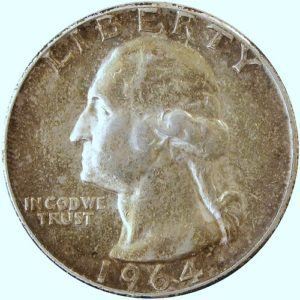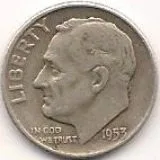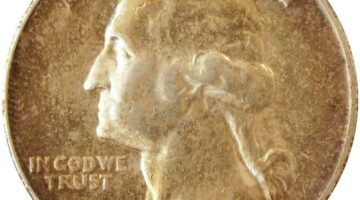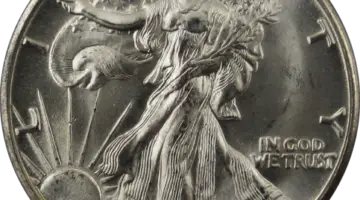“How much are my silver coins worth?” That’s a question I frequently get these days.
When people ask me about silver coin values here at The Fun Times Guide to Coins, I remember when I was just getting into the hobby of coin collecting in 1992 and trying to find out how much my old coins were worth. Some were worth a tidy sum, but most were valued at only a few bucks each.
It wasn’t always easy to find coin values back in those days. There was no Internet — I had to go to the bookstore or library to find coin value guides.
Not only has technology improved since the 1990s, but so have silver prices:
- Back then, an ounce of silver was worth between $4 and $6. Today, silver values may differ $4 to $6 in a month.
- Silver had spiked to more than $35 per ounce in 2011. Now, it’s settled closer to $20.
But that’s still multiples more than what silver was worth when I got into the hobby of coin collecting!
Factors That Determine What Your Silver Coins Are Worth
When people ask me how much their silver coins are worth, I like to remind them of these things:

- Many silver coins aren’t as valuable as you may think. Find an old silver dollar in the basement? Chances are, it will barely pay for a cheap dinner for 2. While century-old silver coins seem like they should be worth hundreds or even thousands of dollars, most are quite common and worth only their silver value.
- But don’t forget silver coins are still worth looking for! OK, so chances are most of your old silver coins aren’t worth hundreds of dollars each, but they’re still worth much more than face value. 90% junk silver coins, or common-date silver coins from the 20th century, are highly desired by bullion investors and collectible, too!
- You can find old silver coins in pocket change. Yes, it’s hard, but it’s possible. I know, because I’ve done it more than a few times. Of course, any silver coin I find in pocket change is worth more than face value, so that’s an automatic profit. Don’t forget to check rolls of coins from the bank, too.
So, How Much Are Your Silver Coins Worth?
Silver coins are generally worth their bullion value plus a numismatic value (an amount based on the collectibility of the coin independent of its metal, or intrinsic, value).
See the current bullion value for silver and the current numismatic value for silver coins.
Here’s a rundown of what the most common types of U.S. silver coins are worth:

1943 Silver Pennies
Did you come here trying to find out how much your silver penny is worth? Unfortunately, 1943 silver pennies aren’t made from silver at all — but rather zinc-coated steel. They’re pretty common and in circulated condition are worth from 15 cents to 50 cents.
Wartime Silver Jefferson Nickels

Jefferson nickels from late 1942 through 1945 are made from a composition that is 35% silver (and 56% copper and 9% manganese). Nickel was removed from the composition to be used instead for World War II artillery. Wartime silver nickels are easily distinguishable from “regular” Jefferson nickels because they all have a large “P,” “D,” or “S” mintmark over the dome of Monticello on the reverse of the coin. In fact, the 1942 wartime nickel was the first U.S. coin to bear a P (Philadelphia) mint mark.
War nickels are popular with collectors and represent an easy, affordable set to build. Circulated silver Jefferson wartime nickels are worth approximately $1 to $2 each. Generally speaking, low-grade wartime nickels can purchased for less than $2 apiece when silver is around $20 to $22 per ounce.
Silver Roosevelt Dimes

From 1946 through 1964, circulating Roosevelt dimes were made from a 90% silver composition. While they’re seemingly impossible to find in circulation these days, silver Roosevelt dimes are actually quite common and are worth between $1.50 and $3 in well-worn grades.
Roosevelt dimes represent a set of coins which are relatively easy to collect and among the least expensive series to complete — with most costing less than $5 to $7 (even in uncirculated grades). Well-worn examples can sometimes be had for only pennies more than the current spot price.
Did You Know?… Franklin Delano Roosevelt, who has been featured on the dime since 1946, started the March of Dimes, an organization that was originally founded to help combat polio — a paralytic disease Roosevelt had battled since 1921. When he passed away in 1945, it was therefore a natural choice to place his portrait on the dime.
Mercury Dimes

Actually bearing the bust of Miss Liberty in a winged cap (not the Greek god Mercury, as commonly thought), Mercury dimes were minted from 1916 to 1945 and designed by Adolph A. Weinman. Many coin collectors love Mercury dimes, also widely known as Winged Liberty Head dimes.
Most Mercury dimes are common — especially those from the late 1920s to 1945 — and are worth $2 to $4 in well-worn grades. Among regular-issue pieces, there is only one considerably rare Mercury dime — the 1916-D dime, which is worth around $850 to $1,000 in a grade of Good-4. The other significantly scarce Mercury dimes — the 1921, and 1921-D issues, are also valuable and worth $50 to $100 in lower circulated grades.

Barber Dimes
Struck from 1892 to 1916, Barber dimes (also called Liberty Head dimes, but widely referred to as “Barber dimes” for the namesake of the coin’s designer, Charles Barber) are a nice piece of Americana whose common dates in the lower circulated grades can be usually had for $3 to $7 apiece.
Standing Liberty Quarters
Made from 1916 through 1930, Standing Liberty quarters are one of the most popular series among the classic 20th-century silver coins. They were designed by sculptor Hermon A. MacNeil and were struck in 2 different motifs:
- Type I Standing Liberty quarters (1916-1917) show a bare-breasted Miss Liberty
- Type II Standing Liberty quarters (1917-1930) show Miss Liberty’s chest covered in a chain mail
While many of the Standing Liberty quarters made from 1916 to the early 1920s are scarce, virtually all from 1925 to 1930 are highly common and popular pieces among both coin collectors and silver investors. Standing Liberty quarters are worth about $5 to $8 and up in lower-circulated grades. Dateless Standing Liberty quarters (which are simply very worn specimens that were struck from 1916 to 1924) generally have a value of about $7.
Silver Washington Quarters

The first Washington quarters — from 1932 through 1964 — were made with a 90% silver composition. With the exception of a few dates, regular-issue silver Washington quarters are common and have a value of $4 to $7 in well-worn grades.
Did You Know?… The original portrait on the George Washington quarter was based off an 18th-century sculpture of the nation’s first president by French sculptor Jean-Antoine Houdon.
Barber Quarters

With the same obverse design as the Barber dime, the Barber quarter is another 1892 to 1916 series which has many dates yielding low prices any collector can afford.
Common-date, well-worn Barber quarters can be found ranging from $10 to $12 each.
Walking Liberty Half Dollars

Widely considered the most beautiful silver coins in the world, Walking Liberty half dollars were struck from 1916 through 1947. Walking Liberty half dollars are highly popular coins that are, thankfully for those on a budget, not very expensive. While earlier Walking Liberty half dollars can cost more than $20 in the lower grades, those struck during the 1940s can be had for only $8 to $10 in well-worn condition.
Made from a 90% silver composition, many Walking Liberty half dollar are considerably scarce — especially in the higher grades. However, most Walking Liberty half dollars dated 1934 or later are quite common, and in well-circulated grades they’re worth $5 to $10 (or only a slight premium above their silver value).
Franklin Half Dollars

From 1948 through 1963, the U.S. Mint struck Franklin half dollars in honor of famous inventor, diplomat, and Founding Father Benjamin Franklin.
Virtually all Franklin half dollars are common — which makes them a great set for coin collectors on a budget. The vast majority of dates in the Franklin half-dollar series are gaining in popularity among both coin collectors and silver investors — largely because they are so common and easily obtainable. The value of Franklin silver half dollar coins starts at around $7 to $10 — even in well-worn circulated grades.
Barber Half Dollars

Struck from 1892 to 1915, Barber half dollars have the same obverse design as the Barber dime and Barber quarter.
Barber half dollars, even in their lowest grades, have seen rising price tags in recent years. “Good” quality Barber half dollars were selling for as little as $5 during the mid-to-late 1990s. Many of these same common-date coins today start at $20 to $25.
Silver Kennedy Half Dollars

The first Kennedy half dollars were made in 1964, just weeks after President John F. Kennedy’s assassination in Dallas, Texas. They were struck in a 90% silver composition. The silver composition changed in 1965 to 40% silver and remained that way through 1970. Beginning in 1971, circulating Kennedy half dollars were made in copper-nickel clad.
- 90% silver 1964 Kennedy half dollars are worth $6 to $9 each
- 40% silver Kennedy half dollars made from 1965 through 1969 are worth $3 to $5 each
- 1970 Kennedy half dollars were made only for collectors and struck at the Denver Mint — they’re worth $12 to $15
Morgan Dollars

One of the most classic and widely recognized of all U.S. coins is the Liberty Head dollar, a coin more popularly known as the Morgan dollar. Designed by coin engraver George T. Morgan, the Morgan dollar was minted from 1878 through 1904 and again in 1921. Many Morgan dollars are advertised online, in magazines, and on TV — as a result, these old coins are familiar even to non-collectors.
Morgan dollars are widely sought by both collectors and investors because of their size, heft, and classic design. Tens of millions of Morgan silver dollars were minted — and millions exist to this day. Many Morgan dollars are scarce (some are even rare), but most dates (especially the 1921 Morgan dollar) are highly common. Most well-circulated, common-date Morgan dollars are worth $18 to $25.
Peace Dollars

As the nation came out of World War I, the U.S. Mint began striking Peace dollars, a design by Anthony De Francisci bearing an obverse design strikingly evocative of the head of the Statue of Liberty. They were struck from 1921 to 1935. They did not enjoy the longevity of their predecessor Morgan dollars, nor did they even achieve the same fame. Yet, they are still one of the most beloved 20th-century U.S. silver coins and are popular with coin collectors.
Many Peace dollar dates are somewhat scarce. For example, 1921 issues are expensive, as are many of the strikes produced during the 1930s. However, Peace dollars from 1922 through 1926 are common and worth $17 to $25, depending on the price of silver per ounce.
Silver Eisenhower Dollars

When the U.S. officially returned to making dollar coins in 1971 after a 36-year hiatus, the nation honored its 34th president — Dwight D. Eisenhower. He had recently passed away in 1969 when the effort came to honor the former Commander-in-Chief and World War II general on the new dollar coin.
Circulating Eisenhower dollars were made from 1971 through 1978 and have a copper-nickel clad composition. However, some business-strike and proof Eisenhower dollars were struck in a 40% silver format — those silver Eisenhower dollar coins are generally worth $5 to $10.
American Silver Eagles

When the United States Mint began making bullion coins in 1986, the American Silver Eagle quickly became a popular coin. Made from 1 ounce of 0.999 fine silver, the Silver Eagle is the least expensive of the nation’s bullion coins. Silver Eagle coins are popular among investors. However, with the beautiful Adolph A. Weinman Walking Liberty design (seen on half dollars from 1916 to 1947), the American Silver Eagle is a favorite among coin collectors, too.
Most American Silver Eagles from the 1980s and 1990s carry significant numismatic premiums, but those made since the 2000s are worth close to their spot value. Values fluctuate based on prevailing silver values, but as of late these coins are worth around $35 to $40.
Which Silver Coins Are The Most Valuable?
Some silver coins are worth hundreds and even thousands of dollars. Which ones are they?
Here’s a list of just a few of the most valuable silver coins:
- Silver 3 Cent Coin (1851-1873) — $20 and up
- Flowing Hair Half Dimes (1794-1795) — $1,250 and up
- Draped Bust Half Dimes (1796-1805) — $1,000 and up
- Capped Bust Half Dimes (1829-1837) — $50 and up
- Liberty Seated Half Dimes (1837-1873) — $15 and up
- Draped Bust Dimes (1796-1807) — $1,000 and up
- Capped Bust Dimes (1809-1837) — $35 and up
- Liberty Seated Dimes (1837-1891) — $10 and up
- Barber Dimes (1892-1916) — $5 and up
- Liberty Seated 20 Cent Coin (1875-1878) — $100 and up
- Draped Bust Quarters (1796-1807) — $500 and up
- Capped Bust Quarters (1815-1838) — $100 and up
- Seated Liberty Quarters (1838-1891) — $20 and up
- Barber Quarters (1892-1916) — $8 and up
- Flowing Hair Half Dollars (1794-1795) — $1,000 and up
- Draped Bust Half Dollars (1796-1807) — $225 and up
- Capped Bust Half Dollars (1807-1839) — $50 and up
- Seated Liberty Half Dollars (1839-1891) — $30 and up
- Barber Half Dollars (1892-1915) — $15 and up
- Flowing Hair (1794-1795) — $1,500 and up
- Draped Bust Dollars (1795-1804) — $900 and up
- Seated Liberty Dollars (1840-1873) — $250 and up
- Trade Dollars (1873-1885) — $100 and up
To see current prices of U.S. silver coins, visit the Professional Coin Grading Service’s coin pricing guide. Or use this handy silver coin calculator.
How To Find Silver Coins In Circulation
Interested in collecting silver coins? Curious which ones are the best to collect?
While further involvement in the hobby will expose you to new coins that you may find quite appealing, the coins listed above are the most popular (and generally inexpensive) U.S. silver coins that can, in their lowest grades, be had for a relatively inexpensive price — often for little more than the coin’s bullion value.
If you’re a new coin collector looking to add silver coins to your collection, you need to know 2 things:
- Silver coins have not been seen in general circulation since the 1960s, and therefore will be difficult to obtain without shopping for them at a coin dealer.
- Many silver coins can be had for only a nominal mark-up over the bullion value, making some silver coins very easy to afford.
It’s possible to find silver coins and other old coins in pocket change and bank rolls, but you’ll have to search through a lot of coins and look really carefully.
Check out this video I made several years ago of my silver coin finds in bank rolls:
You might find silver coins in your loose change with careful searching. I’ve found silver wartime Jefferson nickels, silver Roosevelt dimes, and silver Washington quarters this way!
Whether you have only a few common silver coins worth just a few dollars each or a huge collection of rare silver coins worth hundreds of dollars, your silver coins are nevertheless obsolete collectibles containing precious metal.
Protect your silver coins and they’ll look great for many years to come!
The Bottom Line
Silver coins are popular among investors and collectors alike — not only because they are one of the cheapest types of precious metal coins, but also because many silver coins have beautiful or time-honored designs that are appreciated by coin collectors.
While the monetary value of silver coins is always in flux, what is stable about silver coins is this: their widespread appeal!
No matter what happens to the value of the silver coins you buy, they will always be popular among coin collectors and – at the very least – are worth their face value.
More Info About Silver Coin Values
- Silver Coin Prices & The Silver Coin Market
- The Joys & Challenges Of Collecting American Silver Eagle Coins
- Junk Coins: Perfect For Investors & Collectors On A Budget
- A List of U.S. Coins Worth More Than Face Value
- How Much Nickel Is In A Nickel? Is There Silver In Silver Coins?
- Collecting Silver Coins On A Shoestring Budget
I’m the Coin Editor here at TheFunTimesGuide. My love for coins began when I was 11 years old. I primarily collect and study U.S. coins produced during the 20th century.
I’m a member of the American Numismatic Association (ANA) and the Numismatic Literary Guild (NLG) and have won multiple awards from the NLG for my work as a coin journalist. I’m also the editor at the Florida United Numismatists Club (FUN Topics magazine), and author of Images of America: The United States Mint in Philadelphia (a book that explores the colorful history of the Philadelphia Mint). I’ve contributed hundreds of articles for various coin publications including COINage, The Numismatist, Numismatic News, Coin Dealer Newsletter, Coin Values, and CoinWeek.
I’ve authored nearly 1,000 articles here at The Fun Times Guide to Coins (many of them with over 50K shares), and I welcome your coin questions in the comments below!








